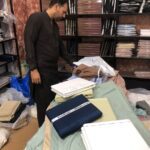Regarding travel, every detail matters, especially your choice of clothing. The suitable fabric can distinguish between a comfortable journey and frustrating wardrobe malfunctions. Men’s travel fabric is designed to be durable, comfortable, and low-maintenance, ensuring that you look sharp and feel great, whether on a plane, hiking in the mountains, or exploring a new city. This guide explores everything you need to know about men’s travel fabric, from the most important facts and trends to expert insights and creative ideas.
What are the Most Important Facts and Statistics about Men’s Travel Fabric?
Men’s travel fabric is engineered to meet the unique demands of travel. It’s often lightweight, wrinkle-resistant, moisture-wicking, and quick-drying, making it ideal for various climates and activities. Key facts to consider include:
Wrinkle Resistance:
Most travel fabrics are designed to resist wrinkles, allowing you to stay fresh without ironing your clothes after unpacking.
Moisture-Wicking:
Fabrics like merino wool and specific synthetic blends are excellent at wicking moisture away from the body, keeping you dry even in humid conditions.
Quick-Drying:
Quick-drying fabrics are essential for travellers, especially those who need to wash clothes on the go or are caught in a sudden downpour.
Lightweight:
Lightweight fabrics are more accessible to pack and carry, making them a favourite for travellers trying to minimize luggage.
Explain the Current Trends and Future Predictions in Men’s Travel Fabric
The travel fabric industry is evolving, with a growing focus on sustainability and multi-functionality. Some of the current trends include:
Sustainable Fabrics:
There’s a rising demand for eco-friendly travel fabrics from recycled materials or organic fibres. Brands are increasingly incorporating sustainable practices in their production processes.
Multi-Functionality:
Modern travel fabrics are designed to be versatile, often serving multiple purposes, such as being reversible, offering UV protection, or incorporating antimicrobial properties to reduce odours.
Tech-Integrated Fabrics:
As technology advances, we see fabrics that include features like embedded insect repellent or temperature regulation, enhancing comfort during travel.
In the future, we can expect more innovations in fabric technology, such as bright fabrics that adjust to body temperature or environmental changes, further enhancing the travel experience.
Who are the Key Influencers or Experts in Men’s Travel Fabric, and What are Their Viewpoints?
Key influencers in the travel and fashion industries often advocate for using high-performance fabrics that combine style and functionality. Experts like fashion designers, textile engineers, and travel bloggers significantly shape consumer preferences. Their viewpoints emphasize the importance of quality, durability, and sustainability in choosing travel fabrics. They often recommend comfortable and adaptable fabrics to various travel scenarios, such as long flights, unpredictable weather, and different cultural settings.
Summarize the Main Arguments and Conclusions of the Article on Men’s Travel Fabric
A well-rounded article on men’s travel fabric typically discusses the importance of choosing the suitable fabric based on the type of travel, climate, and personal preferences. It might conclude by recommending specific fabrics like merino wool for their moisture-wicking properties or synthetic blends for durability and wrinkle resistance. The article would also likely highlight the growing trend towards sustainable fabrics, urging readers to consider eco-friendly options in their travel wardrobe.
What are the Key Takeaways from This Study or Report on Men’s Travel Fabric?
Key takeaways from a study or report on men’s travel fabric might include:
Performance:
The performance of travel fabrics in terms of comfort, durability, and maintenance is crucial for travellers.
Sustainability: There’s a significant push towards using sustainable materials in travel fabrics, influencing production and consumer choices.
Adaptability:
Fabrics that can adapt to different climates and activities are highly valued by travellers, leading to an increase in multi-functional fabric options.
Provide a Concise Summary of the Pros and Cons Discussed in the Article about Men’s Travel Fabric
Pros:
Comfortable:
Most travel fabrics are designed for comfort, offering breathability and moisture-wicking properties.
Low-Maintenance:
These fabrics are typically wrinkle-resistant and quick-drying, making them easy to care for on the go.
Lightweight:
They are often lightweight, making them ideal for packing light.
Cons:
Cost:
High-quality travel fabrics can be more expensive than regular fabrics.
Limited Styles:
Some travel fabrics may offer fewer style options compared to traditional fabrics.
Sustainability Concerns:
Not all travel fabrics are eco-friendly, so choosing brands prioritising sustainability is essential.
What are Some Unique Angles or Perspectives on Writing about Men’s Travel Fabric?
The Evolution of Travel Fabrics:
Explore how travel fabrics have evolved, from heavy wool to lightweight synthetics, and how these changes have impacted travel fashion.
Sustainability in Travel Fabrics:
Discuss the role of sustainable practices in producing travel fabrics and highlight brands leading the way.
Travel Fabric Care Tips:
Offer practical advice on caring for travel fabrics to extend their lifespan and maintain their performance during trips.
What are the Most Common Questions People Ask about Men’s Travel Fabric, and How Can They Be Addressed?
What is the best fabric for hot climates?
Answer with suggestions like linen and lightweight cotton for breathability.
How do I prevent wrinkles in my travel clothes?”
We recommend wrinkle-resistant fabrics like synthetic blends, and we provide packing tips.
Are there eco-friendly travel fabrics available?
Explain their benefits and highlight sustainable options like organic cotton and recycled polyester.


